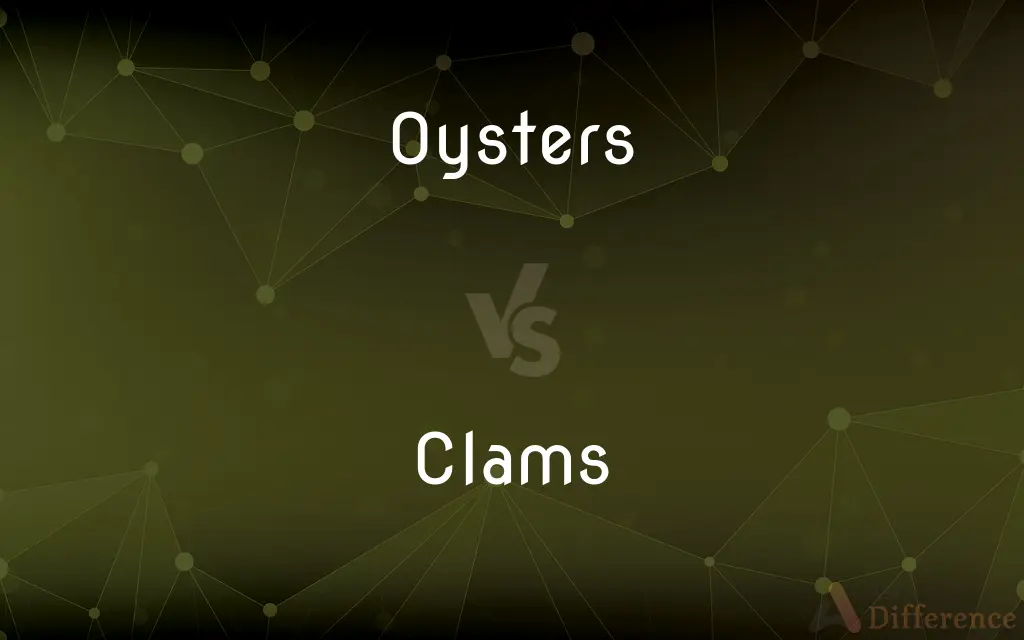Oysters vs. Clams — What's the Difference?
By Tayyaba Rehman — Published on January 24, 2024
Oysters are saltwater mollusks known for their irregularly shaped shells and pearls, often eaten raw or cooked. Clams are bivalve mollusks, found in freshwater and saltwater, with more symmetrical shells, commonly used in various cooked dishes.

Difference Between Oysters and Clams
Table of Contents
ADVERTISEMENT
Key Differences
Oysters have a more irregular and rough shell exterior, often forming in clusters. Their shells tend to be flatter and can vary greatly in shape and size. Clams, in contrast, usually have a more uniform and smoother shell, which is generally rounder or oval and symmetrical. The shell shapes affect how they are harvested and prepared, with oysters often being shucked while still raw and clams typically cooked in their shells.
In terms of habitat, oysters are primarily saltwater creatures, thriving in marine environments, particularly in estuaries and along coastlines. Clams are more versatile, found in both freshwater and saltwater environments. This difference in habitat influences their respective flavors, with oysters having a distinct briny taste and clams offering a more subtle flavor.
Oysters are renowned for their ability to produce pearls, a unique feature amongst shellfish. Pearls form as a defense mechanism against foreign substances inside the shell. Clams, on the other hand, do not produce pearls. While both are valued for their culinary uses, oysters have this additional unique aspect in the world of jewelry and ornamentation.
Culinary uses of oysters vary, but they are famously consumed raw, often served on the half shell, or cooked in dishes like stews and chowders. Clams are more commonly used in cooked preparations, such as in clam chowder, pasta dishes, or steamed with herbs. The texture of oysters is generally softer and more delicate, while clams have a chewier consistency.
Comparison Chart
Shell Shape
Irregular, rough, and variable
More uniform, smooth, and symmetrical
ADVERTISEMENT
Habitat
Mostly saltwater environments
Both freshwater and saltwater environments
Pearl Production
Capable of producing pearls
Do not produce pearls
Taste and Texture
Briny taste, softer texture
Milder taste, chewier texture
Culinary Use
Eaten raw or cooked, delicacy status
Typically cooked, used in various dishes
Compare with Definitions
Oysters
Marine Mollusks: Saltwater shellfish.
We collected oysters during low tide.
Clams
Culinary Versatility: Used in various cooked dishes.
I love adding clams to my seafood pasta.
Oysters
Briny Flavor: Known for their distinct sea taste.
Oysters have a rich, briny flavor that's reminiscent of the ocean.
Clams
Mild Flavor: Subtler taste compared to oysters.
Clams add a gentle, sweet flavor to the chowder.
Oysters
Irregular Shells: Have unique, rough shells.
Oyster shells vary greatly in shape and size.
Clams
Chewy Texture: Known for their firmer texture.
The clams in this dish have a pleasant chewy texture.
Oysters
Pearl Producers: Known for forming pearls.
The pearl in my necklace came from an oyster.
Clams
Bivalve Mollusks: Found in freshwater and saltwater.
We went clamming in the bay area.
Oysters
Culinary Delicacy: Often eaten raw.
Fresh oysters are a must at the seafood restaurant.
Clams
Symmetrical Shells: Characterized by their round, smooth shells.
Clam shells often look like perfect halves.
Oysters
Any of several edible bivalve mollusks of the family Ostreidae, having a rough, irregularly shaped shell attached to the substrate in shallow marine waters. Oysters are widely cultivated for food.
Clams
Any of various usually burrowing marine and freshwater bivalve mollusks chiefly of the subclass Heterodonta, including members of the families Veneridae and Myidae, many of which are edible.
Oysters
Any of various similar or related bivalve mollusks, such as the pearl oyster.
Clams
The soft edible body of such a mollusk.
Oysters
An edible bit of muscle found in the hollow of the pelvic bone of a fowl.
Clams
(Informal) A close-mouthed person, especially one who can keep a secret.
Oysters
A special delicacy.
Clams
(Slang) A dollar
Owed them 75 clams.
Oysters
Something from which benefits may be extracted.
Clams
A clamp or vise.
Oysters
(Slang) A close-mouthed person.
Clams
To hunt for clams.
Oysters
To gather, dredge for, or raise oysters.
Clams
Plural of clam
Oysters
Plural of oyster
Clams
Informal terms for money
Common Curiosities
What are oysters?
Oysters are saltwater mollusks with irregular shells, often eaten raw.
Can oysters be cooked?
Yes, oysters can be cooked, often found in stews and chowders.
What are clams?
Clams are bivalve mollusks found in both freshwater and saltwater, commonly used in cooked dishes.
What's the taste difference between oysters and clams?
Oysters have a briny, sea-like taste, while clams are milder and slightly sweet.
What are popular dishes made with oysters?
Oyster Rockefeller, oyster stew, and raw oysters on the half shell are popular.
Are clams ever eaten raw?
Clams are generally not eaten raw; they are usually cooked.
Is there a texture difference between oysters and clams?
Yes, oysters have a softer texture, while clams are chewier.
Can clams produce pearls?
No, clams do not produce pearls like oysters.
What is the main habitat for oysters?
Oysters predominantly live in marine, saltwater environments.
Do oysters produce pearls?
Yes, oysters are known for their ability to produce pearls.
Are oysters good for your health?
Oysters are nutritious, rich in minerals like zinc and iron.
Are clams a healthy food choice?
Clams are also healthy, offering a good source of protein and vitamins.
What are some common clam dishes?
Clam chowder, linguine with clam sauce, and steamed clams are well-liked dishes.
Can clams live in both freshwater and saltwater?
Yes, clams can thrive in both freshwater and saltwater habitats.
How do you choose fresh oysters and clams?
Fresh oysters and clams should have closed shells and a fresh, ocean smell.
Share Your Discovery

Previous Comparison
HK416 vs. MR556
Next Comparison
Tacoma SR vs. Tacoma SR5Author Spotlight
Written by
Tayyaba RehmanTayyaba Rehman is a distinguished writer, currently serving as a primary contributor to askdifference.com. As a researcher in semantics and etymology, Tayyaba's passion for the complexity of languages and their distinctions has found a perfect home on the platform. Tayyaba delves into the intricacies of language, distinguishing between commonly confused words and phrases, thereby providing clarity for readers worldwide.
















































